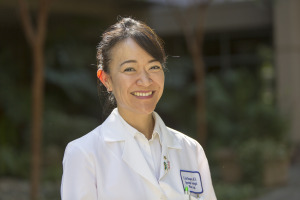
Elizabeth (Betty) Suh-Burgmann, MD, chair of gynecological oncology for Kaiser Permanente’s Northern California Region, has been doing research to improve clinical care of gynecologic cancer throughout her career.
With ultrasounds being performed on patients more often, occasionally abnormalities are discovered that doctors weren’t initially looking for. Dr. Suh-Burgmann was interested in small, complex, ovarian masses discovered in women over age 50, who are at greater risk of ovarian cancer than younger women. While difficult to treat successfully in its later stages, ovarian cancer has a good prognosis if found early. However, the only way to know immediately if these small masses are cancerous is to remove them surgically, leading some women to have surgery for non-cancerous masses.
Dr. Suh-Burgmann reviewed the charts of approximately 1,800 KP NCAL members and identified 1,400 who had these masses. Her research showed that the rate of malignancy was quite low among the group of small, complex, ovarian masses she studied. The findings were published online Sept. 8 in the American Journal of Obstetrics and Gynecology. We sat down with her recently to talk about her work and the findings of this study.
Q: Your research resulted in new clinical practice guidelines. Tell us about them.
A: In April we implemented new radiology templates and practice recommendations in Northern California that are designed to reduce the number of unnecessary surgeries while identifying cancers more readily. Providers and radiologists like using them because they have a clear, recommended, evidence-based path for what to do based on the ultrasound and clinical characteristics of masses. Our shared goal is to spare women unnecessary surgery while providing assurance that worrisome masses receive prompt evaluation.
Q: Why is ovarian cancer so difficult to detect?
A: Unfortunately, it’s not always possible to distinguish between cancerous and noncancerous masses accurately on an ultrasound. Furthermore, levels of the CA125 protein, which is specific to ovarian cancer, are elevated in only half of women who have early-stage disease. In the majority of women with ovarian cancer, the disease has begun to spread before they have any symptoms.
Q: What kind of masses did you study and why?
A: When a woman has an ovarian mass, there’s always a concern that it’s cancer. Large masses are always removed and tested, but there has been no clear guidance for what to do about smaller masses, which could be cancer or, much more likely, benign tumors or cysts. I looked at masses under 6 centimeters that radiologists described as “complex,” which means that they have ultrasound characteristics that raise some concern for cancer.
Q: How did you do this study?
A: With the help of Yun-Yi Hung, PhD, at the Division of Research, I looked in KP HealthConnect for women age 50 and over who had these small, complex masses, no symptoms of disease, and no elevated CA125 levels, to see what happened to them. I was here many evenings, reviewing charts. I got really efficient at it.
This is the first large, population-based study that actually looks at the risk of ovarian cancer in this group. The actual rate of malignancy was quite low. Only seven out of 1,362 of these masses were actually cancer—just one in 200. That’s a lot lower rate than most women’s-health providers have been taught to assume. Also, no masses that remained stable for more than 7 months later turned out to be a cancer or borderline tumor.

